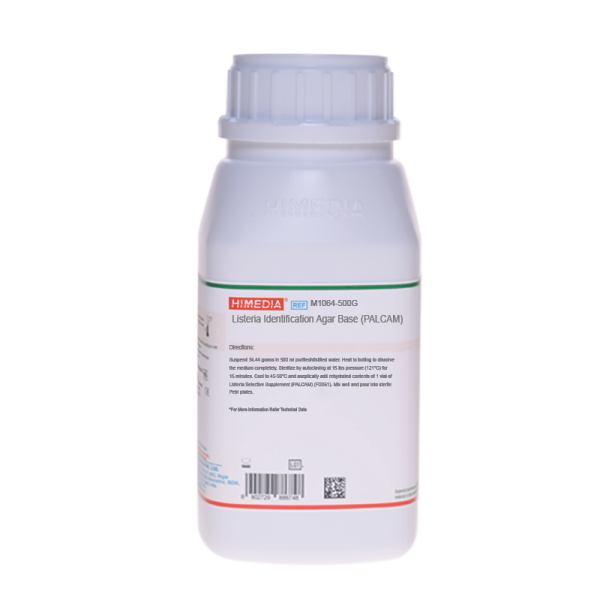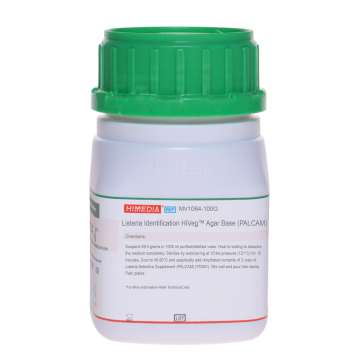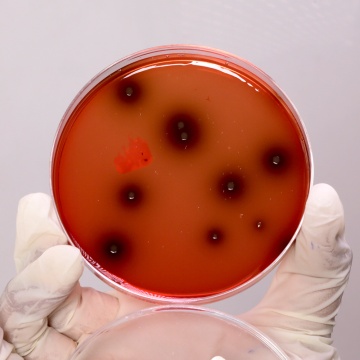 Your enquiry has been submitted
Your enquiry has been submitted
Listeria Identification Agar Base (PALCAM)
Intended use
Recommended for selective isolation and identification of Listeria species from clinical and non-clinical samples.
Composition**
| Ingredients | g/L |
|---|---|
| Peptone | 23.000 |
| Starch | 1.000 |
| Sodium chloride | 5.000 |
| Mannitol | 10.000 |
| Ammonium ferric citrate | 0.500 |
| Esculin | 0.800 |
| Dextrose (Glucose) | 0.500 |
| Lithium chloride | 15.000 |
| Phenol red | 0.080 |
| Agar | 13.000 |
Final pH (at 25°C): 7.0±0.2
**Formula adjusted, standardized to suit performance parameters
Directions
Suspend 34.44 grams in 500 ml purified/distilled water. Heat to boiling to dissolve the medium completely. Sterilize by autoclaving at 15 lbs pressure (121°C) for 15 minutes. Cool to 45-50°C and aseptically add rehydrated contents of 1 vial of PALCAM Selective Supplement (FD061). Mix well and pour into sterile Petri plates.
Principle And Interpretation
The genus Listeria constitutes Listeria monocytogenes, Listeria ivanovii, Listeria seeligeri, Listeria welshimerii, Listeria innocua, Listeria grayi, Listeria murrayi and Listeria denitrificans. Among these, L. monocytogenes and L. ivanovii are associated with diseases in humans. The pathogenicity of L.ivanovii is uncertain. L. monocytogenes is found in a wide variety of habitats, including the normal microflora of healthy ruminants, gastrointestinal tract of asymptomatic humans and environmental sources including river water, sewage, soil, silage, fertilizers and decaying vegetation (1).
Listeria Identification Agar also known as Polymyxin-Acriflavin-Lithium chloride-Ceftazidime-Aesculin-Mannitol (PALCAM) Agar was formulated by Van Netten et al (2) and is recommended for the isolation of L. monocytogenes from foods. PALCAM medium is highly selective due to the presence of lithium chloride, ceftazidime, polymyxin B and acriflavin hydrochloride. PALCAM medium is a differential diagnostic medium utilizing two indicator systems, as esculin and ferric citrate and mannitol and phenol red.
Peptone serves as carbon, nitrogen substances, long chain amino acids, vitamins and essential growth nutrients for the organisms. Dextrose (Glucose), starch and mannitol are the carbohydrate and energy sources. Sodium chloride maintains the osmotic equilibrium of the medium. Phenol red is the pH indicator dye that exhibits changes in the pH of the medium. L. monocytogenes hydrolyzes esculin to form esculetin and dextrose. Esculetin reacts with ammonium ferric citrate and forms a brown-black complex seen as a black halo around colonies. L.monocytogenes does not ferment mannitol but contaminants such as Enterococci and Staphylococci ferment mannitol and is indicated by colour change from red to yellow. Under microaerophilic conditions, strict aerobes such as Bacillus species and Pseudomonas species are inhibited. The addition of egg yolk (2.5% v/v) to PALCAM Agar has been reported to aid repair of damaged cells (3). Medium containing blood when overlaid on PALCAM Agar enables to differentiate and enumerate haemolytic Listeria species (4). Depending upon the type of sample used, selective enrichment broth should be used prior to inoculation onto PALCAM Agar. Generally Listeria Selective Enrichment Medium is used for dairy products and Listeria Selective Enrichment Medium UVM (M890A), Fraser Secondary Enrichment Broth (M1083) are used for meats and poultry. On PALCAM Agar, colonies of Listeria appear as grey-green with a black precipitate, following inoculation and incubation at 35°C for 24-48 hours under aerobic or microaerophilic conditions.
Type of specimen
Clinical samples - faeces, body fluids, Food samples; Water samples
Specimen Collection and Handling:
- For clinical samples follow appropriate techniques for handling specimens as per established guidelines (5,6).
- For food samples, follow appropriate techniques for sample collection and processing as per guidelines (7).
- For water samples, follow appropriate techniques for sample collection, processing as per guidelines and local standards (8).
- After use, contaminated materials must be sterilized by autoclaving before discarding.
Warning and Precautions
In Vitro diagnostic Use. For professional use only. Read the label before opening the container. Wear protective gloves/protective clothing/eye protection/face protection. Follow good microbiological lab practices while handling specimens and culture. Standard precautions as per established guidelines should be followed while handling clinical specimens. Safety guidelines may be referred in individual safety data sheets.
Limitations :
- Individual organisms differ in their growth requirement and may show variable growth patterns on the medium.
- Each lot of the medium has been tested for the organisms specified on the COA. It is recommended to users to validate the medium for any specific microorganism other than mentioned in the COA based on the user's unique requirement.
- The medium is not differential, so further biochemical testing is required for identification between Listeria species.
Performance and Evaluation
Performance of the medium is expected when used as per the direction on the label within the expiry period when stored at recommended temperature.
Quality Control
Appearance Light yellow to pink homogeneous free flowing powder
Gelling Firm, comparable with 1.3% Agar gel.
Colour and Clarity of prepared medium Red coloured clear to slightly opalescent gel forms in Petri plates.
Reaction Reaction of 6.9% w/v aqueous solution at 25°C. pH : 7.0±0.2
pH 6.80-7.20
Cultural Response
Cultural characteristics observed under microaerophilic condition, with added PALCAM Selective Supplement (FD061), after an incubation at 35-37°C for 24-48 hours.
| Organism | Inoculum (CFU) | Growth | Recovery | Colony characteristics |
|---|---|---|---|---|
| Enterococcus faecalis ATCC 29212 (00087*) | 50-100 | none-poor | <=10% | grey colonies with a brown-green halo |
| Listeria monocytogenes ATCC 19111 (00020*) | 50-100 | luxuriant | >=50% | grey-green with black center and a black halo |
| Listeria monocytogenes ATCC 19112 | 50-100 | luxuriant | >=50% | grey-green with black center and a black halo |
| Listeria monocytogenes ATCC 19117 | 50-100 | luxuriant | >=50% | grey-green with black center and a black halo |
| Listeria monocytogenes ATCC 19118 | 50-100 | luxuriant | >=50% | grey-green with black center and a black halo |
| Staphylococcus aureus subsp. aureus ATCC 25923 (00034*) | 50-100 | none-poor | <=10% | yellow colonies with yellow halo |
Key: (*) Corresponding WDCM numbers.
Storage and Shelf Life
Store between 10-30°C in a tightly closed container and the prepared medium at 2-8°C. Use before expiry date on the label. On opening, product should be properly stored dry, after tightly capping the bottle inorder to prevent lump formation due to the hygroscopic nature of the product. Improper storage of the product may lead to lump formation. Store in dry ventilated area protected from extremes of temperature and sources of ignition. Seal the container tightly after use. Product performance is best if used within stated expiry period.
Disposal
User must ensure safe disposal by autoclaving and/or incineration of used or unusable preparations of this product. Follow established laboratory procedures in disposing of infectious materials and material that comes into contact with clinical sample must be decontaminated and disposed of in accordance with current laboratory techniques (5,6).
Reference
- Watkin J., Sleath K. P., J. Appl. Bacteriol., 50: 1-9, 1981.
- Van Netten P., Peralse I, Van de Mosdik A., Curtis G.D.W., Mossel D. A.A., 1989, Int. J. Food Microbiol., 8(4):299.
- Veld P.H. and de Boer E., 1991, Int. J. Food Microbiol., 13:295.
- Van Netten P., van Gaal B. and Mossel D. A. A., 1991, Lett. Appl.Microbiol, 12:20.
- Isenberg, H.D. Clinical Microbiology Procedures Handbook 2nd Edition.
- Jorgensen, J.H., Pfaller, M.A., Carroll, K.C., Funke, G., Landry, M.L., Richter, S.S and Warnock., D.W. (2015) Manual of Clinical Microbiology, 11th Edition. Vol. 1.
- Salfinger Y., and Tortorello M.L. Fifth (Ed.), 2015, Compendium of Methods for the Microbiological Examination of Foods, American Public Health Association, Washington, D.C.
- Lipps WC, Braun-Howland EB, Baxter TE,eds. Standard methods for the Examination of Water and Wastewater, 24th ed. Washington DC:APHA Press; 2023.
| Product Name | Listeria Identification Agar Base (PALCAM) |
|---|---|
| SKU | M1064 |
| Product Type | Regular |
| Physical Form | Powder |
| Origin | Animal |
| Packaging type | HDPE |
| References | 1. Van Netten P., Peralse I, Van de Mosdik A., Curtis G.D.W., Mossel D. A.A., 1989, Int. J. Food Microbiol., 8(4):299. |
| Customized Product Available | No |









